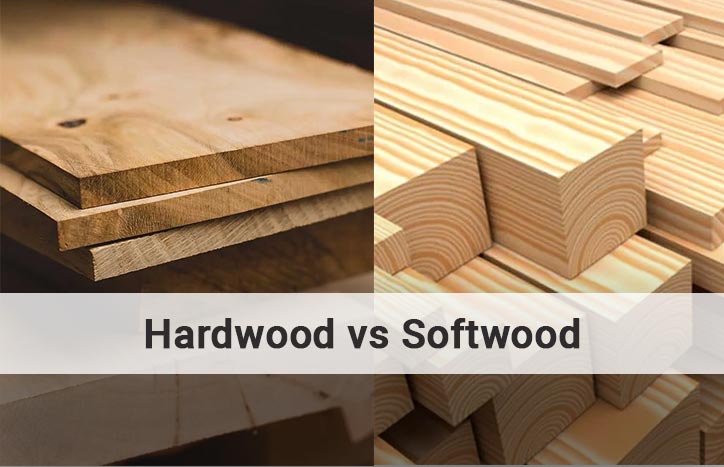Wood
Throughout history, the unique
characteristics and abundance of wood have made it a natural material for homes
and other structures, furniture, tools, vehicles, and decorative objects.
Today, for the same reasons, wood is prized for a multitude of uses.
All wood is composed of cellulose,
lignin, hemicelluloses, and minor amounts (usually less than 10%) of extraneous
materials contained in a cellular structure. Variations in the characteristics
and proportions of these components and differences in cellular structure make
woods heavy or light, stiff or flexible, and hard or soft.
The properties of a single species
are relatively constant within limits; therefore, selection of wood by species
alone may sometimes be adequate. However, to use wood to its best advantage and
most effectively in engineering applications, specific characteristics or
physical properties must be considered.
10 differences between Hardwoods and Softwoods
Trees are divided into two broad
classes, usually referred to as hardwoods and softwoods.
1. Names
These names can
be confusing because some softwoods are actually harder than some hardwoods,
and conversely some hardwoods are softer than some softwoods. For example,
softwoods such as longleaf pine and Douglasfir are typically harder than the
hard- woods basswood and aspen.
2. Botanically
Botanically,
hardwoods are angiosperms; their seeds are enclosed in the ovary of the flower.
Botanically,
softwoods are gymnosperms or conifers; their seeds are not enclosed in the
ovary of the flower.
3. Anatomically
Anatomically,
hardwoods are porous; that is, they contain vessel elements. A vessel element
is a wood cell with open ends; when vessel elements are set one above an-
other, they form a continuous tube (vessel), which serves as a conduit for
transporting water or sap in the tree.
Anatomically,
softwoods are nonporous (they do not contain vessels).
4. Shape
Typically,
hardwoods are plants with broad leaves that, with few exceptions in the
temperate region, lose their leaves in autumn or winter.
Softwoods are
usually conebearing plants with needle- or scale-like evergreen leaves. Some
softwoods, such as larches and baldcypress, lose their needles during autumn or
winter.
5. Places
Most imported
tropical woods are hardwoods.
Major resources
of softwood species are spread across the United States, except for the Great
Plains, where only small areas are forested. The hardwood resource is
concentrated in the eastern United States, with only a few commercial species
found in Washington, Oregon, and California.
6. Examples
Hardwood: trees
include alder, balsa, beech, hickory, mahogany, maple, oak, teak, and walnut.
Softwood: trees
are cedar, Douglas fir, juniper, pine, redwood, spruce, and yew.
7. Density
Hardwoods have a
higher density.
Softwoods have a
lower density.
8. Cost
Hardwood is more
expensive.
Softwood is less
expensive.
9. Growth
Hardwood has a
slower growth rate.
Softwood has a
faster rate of growth.
10. Fire Resistance
Hardwood is more
Softwood poorer
Timber Resources and Uses
In the United States, more than
100 wood species are available to the prospective user; about 60% of these are
of major commercial importance. Another 30 species are commonly imported in the
form of logs, cants, lumber, and veneer for industrial uses, the building
trade, and crafts.
A continuing program of timber
inventory is in effect in the United States through the cooperation of Federal
and State agencies, and new information on wood resources is published in State
and Federal reports. Two of the most valuable sourcebooks are An Analysis of
the Timber Situation in the United States: 1952 to 2050 and The 2005 RPA Timber
Assessment Update. Current information on wood consumption, production, imports,
and supply and demand is published periodically by the Forest Products Laboratory.
Commercial Sources of Wood Products
Softwoods are available directly
from sawmills, wholesale and retail yards, or lumber brokers. Softwood lumber
and plywood are used in construction for forms, scaffolding, framing,
sheathing, flooring, moulding, paneling, cabinets, poles and piles, and many
other building components.
Softwoods may also appear in the
form of shingles, sashes, doors, and other millwork, in addition to some rough
products such as timber and round posts.
Hardwoods are used in construction
for flooring, architectural woodwork, interior woodwork, and paneling. These
items are usually available from lumberyards and building supply dealers. Most
hardwood lumber and dimension stock are remanufactured into furniture,
flooring, pallets, containers, dunnage, and blocking.
Hardwood lumber and dimension
stock are available directly from manufacturers, through wholesalers and
brokers, and from some retail yards. Both softwood and hardwood products are
distributed throughout the United States. Local preferences and the
availability of certain species may influence choice, but a wide selection of
woods is generally available for building construction, industrial uses,
remanufacturing, and home use.
Use Classes and Trends
Major wood-based industries
include those that convert wood to thin slices (veneer), particles (chips,
flakes), or fiber pulps and reassemble the elements to produce various types of
engineered panels such as plywood, particleboard, oriented strandboard,
laminated veneer lumber, paper, paperboard, and fiberboard products. Another
newer wood industry is the production of laminated wood products. The lumber
industry has also produced smaller amounts of railroad crossties, cooperage,
shingles, and shakes.


Comments
Post a Comment